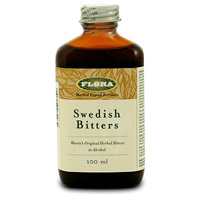It was rediscovered two decades ago, with the discovery of the extraordinary book “Health from the Lord’s Pharmacy” by Maria Treben. A remedy said to cure almost any disease. And it was not far from the truth. By the time the miraculous tincture – a veritable “anthology” of healing herbs – proved to have beneficial effects on health, quickly acquired a deserved celebrity. Millions of bottles of the precious elixir, in all sorts of formulas and dilutions were sold annually throughout the world, Swedish Bitter becoming a symbol of the revival. But what is, in fact, the origin of this remedy? Which of the dozens of formulas that are available on the market now is that good?
Swedish Bitter origin:
It seems that this tincture was discovered by the legendary medieval scholar and alchemist Theophrastus von Hohenheim Bombastus, said Paracelsus, who wanted to create an herbal elixir to prolong youth. After a brilliant success, the miracle elixir fell into oblivion, and was preserved and transmitted only from father to son in a family of Swedish doctors named Samst. It seems that the long life elixir of Paracelsus was really effective, so that all members of families have reached impressive age.
Klaus Samst, rector of the faculty of medicine in Uppsala, for example, was lived the venerable age of 104 years, when he died suddenly because of a fall from his horse. Swedish Bitter again proved its efficiency in an impressive range of diseases, from indigestion and migraines to cancer and diseases of the skin difficult to heal. They appeared on all sorts of bitter versions.
What is actually Swedish Bitter?
Is a hydroalcoholic extract, or in other words, a tincture of bitter herbs. Moreover, it is sometimes called the “Swedish Bitter Aperitif”. Why bitter? Because plants with a bitter taste have a special importance in herbal therapy. The best natural remedies are bitter at taste. Makes our liver and gall bladder strong, stimulates removal processes by enhancing digestive peristalsis and activates digestion by increasing the secretion of gastric juices. In terms of psycho-mental, bitter taste is associated with disappointment – a phrase which, considered in the etymologically, means the discovery, the issue of deception.
Therefore, in holistic medicine, bitter remedies have a very interesting role in a psychological level to help eliminate false beliefs and ideas, in other words, the delusions that lead to disease. Basically, you can not speak of a natural medicine as an effective detoxification process if it does not taste bitter. Well, different variants of Swedish Bitters are an unparalleled collection of bitter herbs, with different shades. That pure bitter herbs (gentian, tintaura, artichoke), aromatic bitter (wormwood, yarrow, bitter orange peel), salt bitter (chicory, dandelion), mucilaginous bitter (Iceland Moss), etc.. For this reason, this bitter elixir is a tremendous drain and detoxifier, which also explains its healing effects in an extremely large range of diseases.
The best Swedish Bitter formula:
Despite its popularity as a cure, so far nobody knows exactly which is the original recipe of Swedish Bitter. In fact, some of its components, such as Venetian theriacul are formulas obtained by alchemical processes, processes which are not currently known. There are thus high probability that today will no longer be prepared as the original bitter made by Paracelsus in the Middle Ages. But that does not preclude its effectiveness. Returning to one of the questions posed at the beginning of this article: “What is the best formula of Swedish Bitter?”, We must recognize that the answer is very difficult to give.
Preparation of a domestic Swedish Bitter:
Here is a recipe for something more simple, consisting of only twelve plants, but well worth putting the principles underlying the composition of the Swedish Bitter:
– In a jar with a cap, with a capacity of 2 liters, place two tablespoons of each of these herbs in powder form (obtained by grinding with an electric coffee grinder): mugwort (Artemisia absinthum), artichoke (Cynara scolymus) Acacia flowers (Robinia pseudoacaccia), bay leaf (Laurus nobilis), grass knotweed (Polygonatum aviculare), leaves of ash (Fraxinus) Angelica root (Angelica archangelica), juniper berry (Juniperus communis).
– Then add 1 teaspoon of powdered tree resin (Abies acorns), seeds of fennel (Foeniculum vulgare), nettle root (Urtica dioica) and half a teaspoon of turmeric powder (Curcuma longa).
– After you put all the plants, add a half liter of potable alcohol of 50-60 degrees and let everything soak for at least two weeks.
– At the end of maceration time, preparation is filtered through gauze and put in storage in a dark bottle in a cool dark place.
It is usually taken 1 to 2 teaspoons of this mixture before meals, diluted in water or tea. What diseases can cure? The list is so extensive that it would probably fill dozens of pages.
